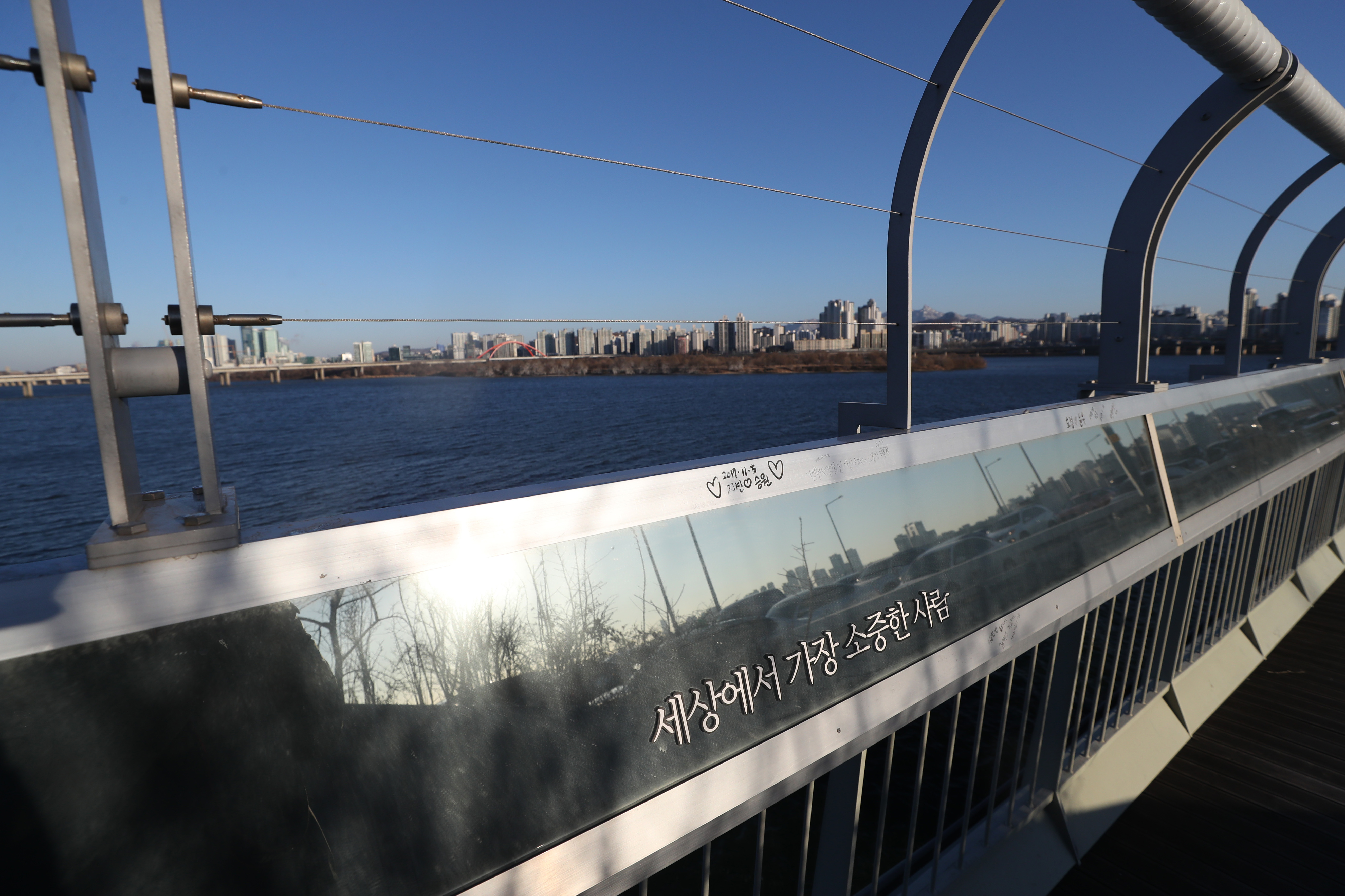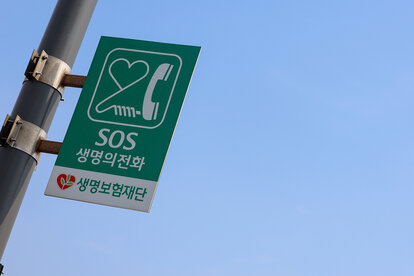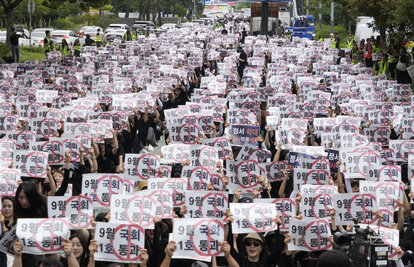South Korea
Suicide in South Korea: “My friend, think about it one more time”

Eine Barriere, die auf der Mapo-Brücke über den Han-Fluss in Seoul installiert wurde, die ein bekannter Ort für Selbstmord ist. Eine koreanische Botschaft mit der Aufschrift "Du bist der wertvollste Mensch der Welt" ist auf der Barriere zu sehen, die den Selbstmord erschweren soll.
© picture alliance / YONHAPNEWS AGENCY | YonhapSouth Korea has by far the highest suicide rate among all OECD countries. With new measures, the government aims to save lives. However, a deeply rooted cause for the high number of suicides is challenging to eliminate: the immense societal pressure on individuals.
On Mapo Bridge in South Koreas capital, life and death are at stake almost daily. Nearly every other day, someone attempts to jump from the bridge over the Han River to end their life.
The frequency of these incidents has led the city administration to install a bronze statue as a memorial in the middle of the bridge: One man comforting another, with the inscription "My friend, think about it one more time " engraved upon it. The intention of this artwork is to dissuade individuals contemplating suicide from jumping. However, despite such efforts, the number of suicide attempts continues to rise annually. In 2022 alone, 255 individuals tried to attempt suicide from the bridge. Fortunately, thanks to surveillance measures, emergency call buttons, and telephones, all jumps could be prevented.
The Mapo Bridge in Seoul has become the focal point of a dramatic and longstanding crisis in South Korea. The country has the highest suicide rate among all OECD nations. According to the latest OECD figures from 2021, the country recorded 24.1 suicides per 100,000 inhabitants. The OECD average is 11.3; in Germany, it's only 9.7.
In Korea, suicide stands as one of the leading causes of death, exceeding traffic accidents and cardiovascular diseases. Over the past three years, close to 40,000 individuals have tragically ended their own lives. Many decide to jump from one of the 31 bridges crossing Han River in Seoul.

Ein Schild mit einem speziellen Telefon, das auf der Mapo-Brücke über den Han-Fluss in Seoul installiert wurde, um Selbstmord zu verhindern.
© picture alliance / YONHAPNEWS AGENCY | YonhapNew Prevention Concept
Despite longstanding efforts, governmental prevention measures have shown limited results. To address this, a new approach focusing on intensified mental health check-ups is being introduced with the aim of substantially reducing suicide rates. In December 2023, President Yoon announced plans to shorten the intervals between recommended psychological assessments using the Patient Health Questionnaire-9 (PHQ-9) from ten to two years, starting in 2025.
The PHQ-9 is an instrument for assessing mental health. It consists of nine questions designed to capture various aspects of mental well-being. These include questions such as: "Over the past two weeks, how often have you been bothered by any of the following problems: little interest or pleasure in doing things or feeling down, depressed or hopeless?"
This measure is voluntary and initially targets individuals aged 20 to 34. It will later be extended to include other at-risk groups. Furthermore, 17 city and provincial governments across the country will implement specialized suicide prevention programs tailored to the specific needs of their regions and age groups.
Furthermore, the government plans to offer psychological counseling to 80,000 individuals this year. Target groups include individuals experiencing suicidal thoughts or those who have experienced a suicide within their family. By 2027, access to psychological support will be extended to one million people.
This initiative aims to combat the stigma surrounding mental health issues in South Korea. The taboo surrounding mental health leads individuals to feel isolated with their problems and hesitate to seek help in a timely manner.
Social change
The reasons for persistently high suicide rates in the East Asian country are complex. Many experts, point to the rapid social transformation experienced by the country in recent decades as a significant challenge for many people: in the 1960s South Korea was one of the poorest countries in the world. Today, it is a leading industrial nation.
Therefore, South Korea experienced what German sociologist Ulrich Beck understands as the individualization of industrial societies extremely quickly. Beck argues that in economically rapidly developing societies, traditional social bonds and values become less binding. This leads to greater freedom for each individual - but can also result in insecurity and isolation.
Additionally, Korea experiences an extremely intense economic and societal competition. "As traditional bonds between family members and neighbors weaken, everyone seems to be fighting this battle for success alone," says Soong-nang Jang, Professor of Public Health at Chung-Ang University.
Especially the younger generation suffers from the high pressure to succeed. For decades, the country has been on the rise, with each generation experiencing better conditions. "But now, economic growth has slowed down, meaning there are fewer good jobs, and the young generation has to fight for these jobs from a young age," says Jinwook Shin, Sociology Professor at Seoul National University.
The pressure to excel starts early and becomes particularly apparent during the college entrance exams. These tests not only determine one's professional future but also their societal standing throughout life. Parents often invest significant amounts of money in their children's education and expect great success in return. Many students begin intensive preparation a year in advance, studying daily until late into the night. This leaves little time for leisure activities or friendships.
In 2022, the number of suicide and self-harm attempts among teenagers was 160.5 attempts per 100,000 inhabitants. Suicide is the leading cause of death among individuals aged between ten and 39 years.

Lehrer halten ihre Plakate während einer Kundgebung für einen besseren Schutz ihrer Rechte in der Nähe der Nationalversammlung in Seoul, Südkorea, am Samstag, 16. September 2023. Nach dem Selbstmord eines Grundschullehrers im Juli drängen Lehrer in ganz Südkorea auf verbesserte Systeme, um Lehrer vor den weit verbreiteten mutwilligen Beschwerden von Eltern zu schützen.
© picture alliance / ASSOCIATED PRESS | Ahn Young-joonThe immense pressure also affects teachers. The number of suicides has steadily increased in recent years. Following the suicide of a young teacher last late summer, the entire professional group's frustration erupted. Tens of thousands took to the streets of Seoul, demanding better protection for teachers. They complained that numerous overambitious parents instrumentalize a law regulating the punishment of child abuse as a weapon against teachers - and called for more legal protection. The law has since been slightly softened.
Pressure for beauty among women
As in many other countries, men commit suicide significantly more often than women. In 2022, there were about 35.3 suicides per 100,000 inhabitants among men and 15.1 per 100,000 inhabitants among women. This can be explained by the fact that men place more value on independence than women and view asking for help as a weakness. Women, on the other hand, are more willing to seek help and are more openly discuss their feelings.
The reasons behind suicidal ideation vary between men and women. Specifically, men in Korea face the expectation of economic success and are under the pressure as the the provider for their families. According to the Korean Statistical Information Service, 35.5 percent of male respondents attribute financial difficulties as the cause of their suicidal thoughts.
On the other hand, among women, psychological strains such as depression are the most prevalent cause of suicidal ideation, accounting for 40.5 percent. Studies indicate a correlation between dissatisfaction with one's appearance and mental health issues. In Korea, an extreme beauty standard prevails: many women aspire to a slim figure weighing under 50 kilograms, fair skin, and a flawless complexion. Due to the high value placed on physical appearance, cosmetic surgeries are extremely common in South Korea.
Many K-Pop stars also promote an unrealistic beauty ideal. An extreme example is the bizarre diet of the singer IU. She only eats an apple for breakfast, a sweet potato for lunch, and drinks a protein shake in the evening.
Besides young people, older individuals are also at risk, particularly due to financial challenges. According to the OECD, South Korea has one of the highest poverty rates among seniors, alongside the highest suicide rate. The pension system is poorly developed.
Even today, in the hypermodern city of Seoul, one can see seniors pulling hand carts through the streets. They search for recyclable materials to sell. Many seniors also live alone in rural areas. The rapid economic changes in the country have drawn young people to the cities.
AI as a lifesaver
In addition to the newly implemented psychological prevention measures, South Korea will also continue to rely on technology and security measures to prevent suicides. For instance, surveillance cameras equipped with Artificial Intelligence are installed on the bridges over the Han River.
The AI-based deep learning system is capable of recognizing situations in real-time and predicting suicide attempts. It identifies behavioral patterns such as hesitation, which may indicate a risk of jumping. In such cases, the system automatically alerts rescue teams, who monitor the behavior and decide if intervention is necessary.
If you're experiencing suicidal thoughts or know someone who needs support, reach out and talk to others about it. There are various support services available here, including anonymous options via chat, phone, email, or in-person conversations.
*Maja Adler is currently completing an internship at the office of the Friedrich Naumann Foundation for Freedom in Seoul.
